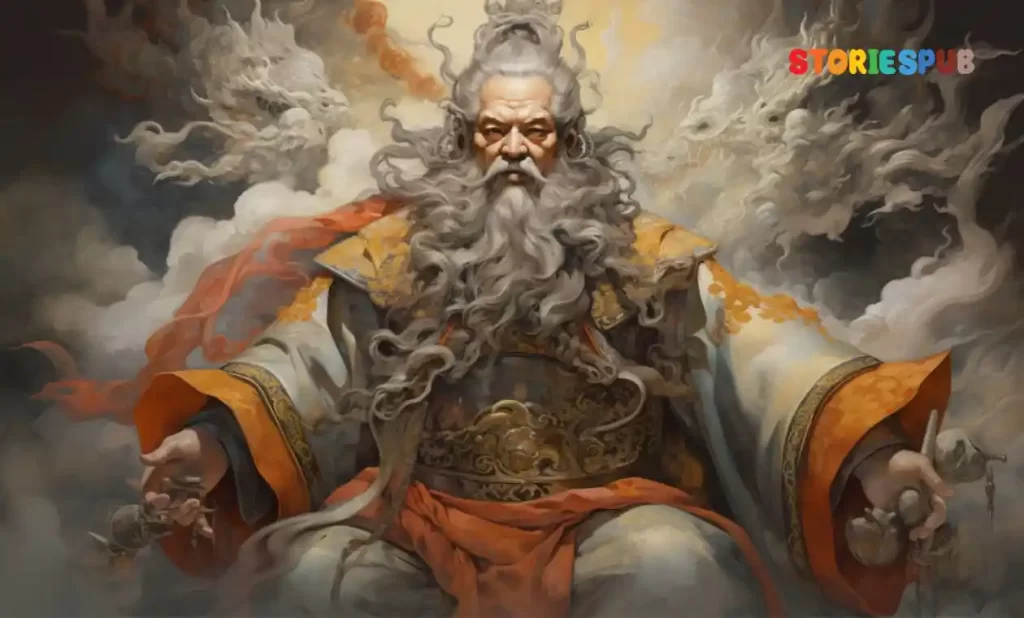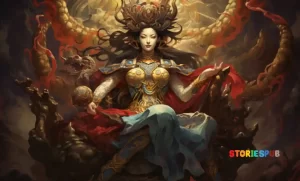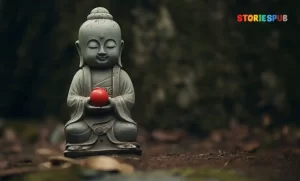
The Life of Hongjun Laozu: A Brief Overview
Hongjun Laozu, also known as Zhang Daoling, is considered the founder of the Taoist religion. He lived during the Han dynasty (206 BC–220 AD) in China and was born in the province of Henan around 34 AD. Hongjun Laozu was a spiritual leader and teacher who developed a unique philosophy that emphasized harmony with nature and meditation. Hongjun Laozu’s life story is surrounded by legends, but it is said that he began his spiritual journey at an early age.
He received a traditional Confucian education but became disenchanted with its teachings and set out to find his own path. After traveling around China for several years, he met a hermit who taught him about alchemy and immortality.
This encounter inspired him to develop his philosophy based on Taoism. Hongjun Laozu founded the Five Pecks of Rice movement, which was a Taoist religious community with its own rituals and beliefs.
The name comes from the practice of offering five pecks of rice to members who joined the movement. The group gained popularity among peasants and farmers who were attracted to its message of equality and liberation from social oppression.
The Importance of Hongjun Laozu in Taoism
Hongjun Laozu’s teachings had a profound impact on Chinese culture, particularly during the Han dynasty when Taoism became one of the major religions alongside Confucianism and Buddhism. His emphasis on living in harmony with nature, meditation, non-action (wu wei), and cultivating inner peace have influenced generations of Chinese people.
In addition to being regarded as one of the founding figures in Taoism, Hongjun Laozu has been revered as a deity by some followers. In modern times, he is still worshipped by millions of people who believe that he has powers to heal and protect them.
Hongjun Laozu’s legacy is also reflected in the Five Sacred Mountains of Taoism, which he established as important pilgrimage sites for Taoists. These mountains are considered to be the dwelling places of immortals and are believed to have special spiritual powers.
Hongjun Laozu’s contributions to Taoism cannot be overstated. His teachings continue to inspire millions of people around the world who seek a deeper understanding of themselves and their place in nature.
Early Life and Background
Birth and Childhood
Hongjun Laozu was born in the province of Shanxi, China, during the Tang Dynasty (618-907 AD). His birth name was Li Er, and he was born into a family of farmers.
From a very young age, Hongjun Laozu showed an interest in spirituality and the natural world. He spent much of his time exploring the mountains and forests near his home, observing the plants and animals around him.
Education and Spiritual Journey
During his teenage years, Hongjun Laozu left home to further his education. He studied under several renowned Taoist masters, including Zhongli Quan and Lu Dongbin. These masters taught him about meditation, alchemy, divination, and other spiritual practices that were common in Taoism at that time.
Through these experiences, Hongjun Laozu developed a deep understanding of Taoist philosophy. He came to believe that all things are interconnected through the Tao – the natural order of the universe – and that humans can live in harmony with this order by following certain principles.
Influences on His Beliefs
Hongjun Laozu’s beliefs were heavily influenced by his experiences with nature. He saw firsthand how everything in nature followed its own path without forcing anything on others or causing harm to any living beings.
He also drew inspiration from ancient Chinese texts such as the I Ching (Book of Changes) and the Tao Te Ching (Book of Reason). These texts emphasized living life simply and naturally while avoiding extremes or excesses.
Overall, Hongjun Laozu’s early life experiences shaped his spiritual beliefs tremendously. Through his study under various teachers combined with personal observations during childhood educations he went onto become one of China’s most important religious figures.
Inspiration from the Tao Te Ching
Hongjun Laozu’s inspiration for founding Taoism came from his deep study of the ancient text, Tao Te Ching. This text, written by Laozi, is a collection of philosophical and poetic verses that describe the fundamental principles of Taoism.
Hongjun Laozu became fascinated with these ideas and dedicated himself to understanding them fully. The central idea in the Tao Te Ching is the concept of “Tao,” which roughly translates to “the way.” The Tao is an abstract notion that represents the natural order of things and the underlying unity that connects everything in existence.
The text also emphasizes concepts such as humility, simplicity, and spontaneity, all of which are central to Taoist philosophy. As Hongjun Laozu studied the Tao Te Ching more deeply, he began to develop his own ideas about how to apply these principles in daily life.
He believed that by living in harmony with nature and cultivating inner peace, individuals could achieve a higher state of consciousness and experience a more fulfilling existence. These ideas formed the basis for his teachings as he went on to found the religion of Taoism.
Creation of the Five Sacred Mountains
One of Hongjun Laozu’s most significant contributions to Taoism was his establishment of five sacred mountains throughout China. These mountains were believed to be key locations for practicing meditation and communing with nature in order to better understand oneself and connect with higher spiritual forces.
Each mountain had its own unique characteristics and symbolism associated with it. Mount Tai represented stability and strength, while Mount Hua represented courage and determination.
Mount Heng was seen as a symbol of harmony between humans and nature, while Mount Song represented wisdom and enlightenment. Mount Hengshan was believed to be a place where individuals could go to seek guidance from divine beings.
For centuries after their creation, these mountains served as important pilgrimage sites for Taoists seeking to deepen their connection with the natural world and the spiritual forces that governed it. Even today, they remain an important part of China’s cultural heritage and a testament to the enduring legacy of Hongjun Laozu’s teachings.
Spread of Taoism throughout China
Hongjun Laozu’s teachings quickly gained popularity throughout China, attracting followers from all walks of life. His emphasis on simplicity and self-discipline resonated deeply with those seeking a more meaningful existence in a rapidly changing world.
As Taoism spread throughout China, it underwent several changes and adaptations to better suit local customs and beliefs. Different schools of thought emerged, each with its own interpretations of Hongjun Laozu’s teachings.
These schools often focused on specific practices, such as alchemy or meditation techniques, but all shared a common belief in the importance of living in harmony with nature. Taoism also had a profound influence on Chinese culture more broadly.
Its emphasis on balance and harmony helped shape traditional Chinese medicine and martial arts practices such as tai chi chuan. Its focus on inner peace and enlightenment has also inspired countless works of art over the centuries, from poetry to painting to calligraphy.
Overall, Hongjun Laozu’s vision for Taoism has had an enduring impact on both Chinese culture and spiritual traditions around the world. His teachings continue to inspire individuals seeking greater inner peace and connection with nature today.
Teachings and Beliefs
Hongjun Laozu’s teachings and beliefs form the foundation of Taoism. Although Taoism has evolved into various sects over the centuries, his teachings remain essential to all of them. His focus on the Three Treasures, Yin-Yang theory, and Wu Wei reflect his understanding of the universe and how individuals could achieve balance with it.
The Three Treasures: Jing, Qi, Shen
The Three Treasures represent the fundamental aspects of human existence according to Hongjun Laozu’s teachings. These treasures encompass physical, energetic, and spiritual dimensions that need to balance to overcome suffering. Jing (Essence) is associated with physicality and vitality.
It represents an individual’s genetic potential for life force energy. Hongjun Laozu believed that Jing is present in every cell from birth until death, but it could be conserved or depleted based on lifestyle choices like diet or sexual behavior.
Qi (Energy) represents a person’s vital energy or life force. It is linked to breath control in Taoist practices like Qigong or Tai Chi.
Qi flows through channels known as meridians, which can become blocked or unbalanced by unhealthy habits. The goal for practitioners is to cultivate Qi through meditation and exercise.
Shen (Spirit) encompasses consciousness and awareness beyond materiality. It refers to an individual’s connection with universal consciousness—the source of all things in existence—allowing transcendence from all that limits us in our physical forms.
Yin-Yang Theory
Yin-Yang Theory represents two opposing forces existing within everything in nature: dark/light; soft/hard; passive/active; cold/hot; etc. Hongjun Laozu believed that these forces are complementary rather than contradictory because one cannot exist without the other. The relationship between Yin-Yang signifies harmony, and when equilibrium is lost, it leads to illness or suffering. In Taoism, the goal is to create balance by finding a middle ground between these forces.
Wu Wei (Non-Action)
Wu Wei translates to “non-action” or “effortless action.” This concept represents the idea of acting without intention, letting situations unfold naturally without forcing anything. According to Hongjun Laozu’s teachings, Wu Wei means trusting in the universe’s natural flow and avoiding resistance.
Hongjun Laozu believed that humans are often too willful and try too hard to control everything around them. His teachings emphasize letting go of one’s ego and allowing oneself to be guided by nature rather than fighting against it.
When we practice Wu Wei, we align ourselves with the universe and find inner peace. Hongjun Laozu’s teachings on the Three Treasures, Yin-Yang Theory, and Wu Wei remain at the heart of Taoism even today.
These concepts provide a framework for cultivating balance within oneself and connecting with universal consciousness. By following these principles through meditation, exercise, breathing techniques or spiritual practices like I Ching divination techniques or feng shui consulting services can help individuals achieve greater harmony in their lives.
Legacy and Influence:
Impact on Chinese Culture

Hongjun Laozu’s impact on Chinese culture cannot be overstated. Taoism, which he founded and developed, has been a significant part of traditional Chinese culture for over two thousand years.
Its influence can be seen in literature, philosophy, art, medicine, martial arts, and even in daily life. The Taoist concept of Wu Wei (Non-Action) is a guiding principle for many people in China today who seek to live harmoniously with the natural world.
One significant impact that Hongjun Laozu had was the creation of the Five Sacred Mountains of Taoism: Tai Shan (East), Hua Shan (West), Heng Shan (North), Heng Shan (South), and Song Shan (Central). These mountains are considered sacred by Taoists because they represent the five elements: earth, water, fire, metal and wood.
They also symbolize balance and harmony. The ancient practice of Feng Shui also owes its origins to Hongjun Laozu’s teachings.
Feng Shui is a system of geomancy used to harmonize individuals with their environment through proper orientation and arrangement of buildings, furniture and other elements. This practice has become popular worldwide as well.
Another impact that Hongjun Laozu had on Chinese culture is his influence on traditional Chinese medicine. Many Taoist beliefs are integrated into Traditional Chinese Medicine; for example Yin-Yang Theory which teaches that everything in existence has two complementary yet opposing aspects.
Taoism in Modern Times
Today’s modern society has had an impact on all religious doctrines including Taoism. Many people in China no longer practice strict adherence to traditional religious practices but instead favor new age or non-spiritual lifestyles. Modern society influences have led to what some might consider ‘watering down’ some aspects of the religion as it adapts to fit into the modern world.
Taoism, for instance, is no longer an official state religion like it was under the Tang dynasty. Instead, it has become more of a personal choice of one’s beliefs.
In recent years, Taoism has also gained popularity in the West. Many people are interested in the Taoist teachings and practices such as meditation, Feng Shui and Qi Gong, which promote inner peace and harmony.
Despite its increasing popularity worldwide, many questions still linger around Taoism. Some people are skeptical about some of its practices while others believe that the religion is still very relevant today.
Hongjun Laozu’s legacy has left an indelible mark on Chinese culture through the creation of a harmonious way of living that continues to influence many aspects of life in China today. Though times have changed since its inception two millennia ago, Taoism remains an integral part of traditional Chinese culture and continues to thrive as a viable path for spiritual growth even in the modern era.
Conclusion
Summary of Hongjun Laozu’s life and achievements
Hongjun Laozu, also known as the Taoist patriarch, is one of the most important figures in Chinese history. He was a spiritual leader who founded the Taoist religion and created many of its core beliefs and practices. Throughout his life, he worked tirelessly to promote Taoism and spread its message throughout China, leaving behind a rich legacy that continues to inspire people around the world.
Born into a family of scholars, Hongjun Laozu grew up in a time of great social upheaval. However, he quickly distinguished himself as a brilliant thinker and philosopher.
As he grew older, he became increasingly interested in spiritual matters and began to explore various religions and philosophies. Eventually, he settled on Taoism as his path and dedicated himself to its practice.
Reflections on his contributions to Taoism
Hongjun Laozu’s contributions to Taoism are immeasurable. He was responsible for creating many of its foundational beliefs and practices, which continue to guide millions of people today.
His teachings on non-action (Wu Wei), harmony with nature, and the balance between yin and yang have all had a profound impact on Chinese culture. His creation of the Five Sacred Mountains helped establish Taoism as a major religion in China.
By choosing these five locations as sacred sites for pilgrimage, Hongjun Laozu cemented their importance in Chinese culture and ensured that they would be revered for generations to come. Overall, Hongjun Laozu’s influence on Chinese culture cannot be overstated.
His teachings have helped shape Chinese philosophy for centuries, while his commitment to spreading the message of Taoism has ensured that it remains an important part of modern-day China. Hongjun Laozu was one of the greatest thinkers in Chinese history – a man whose wisdom and insights continue to inspire people around the world. His contributions to Taoism have had a profound impact on Chinese culture, helping shape its philosophy and spirituality for centuries. Although he lived in a different time and place, his teachings remain relevant today, offering guidance and inspiration to people seeking greater harmony with themselves and the world around them.
Hey kids, how much did you like Hongjun Laozu: The Wise Taoist Patriarch and Founder? Please share your view in the comment box. Also, please share this story with your friends on social media so they can also enjoy it, and for more such Chinese Mythology, please bookmark storiespub.com.
Related Post :





